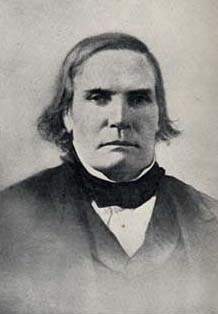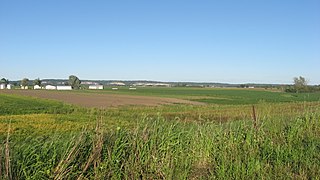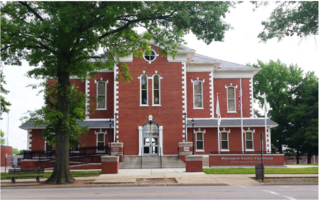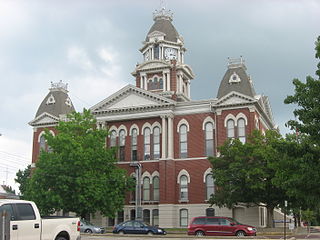
The St. Clair County Courthouse is a government building in Belleville, the county seat of St. Clair County, Illinois, United States. Built in 1976, it is the fifth courthouse in the history of the county, and one of two that still stands.

The St. Clair County Courthouse is a government building in Belleville, the county seat of St. Clair County, Illinois, United States. Built in 1976, it is the fifth courthouse in the history of the county, and one of two that still stands.
Frenchmen settled in the Mississippi River basin at the end of the seventeenth century, founding towns such as Kaskaskia and Cahokia with missions to local Indians. [1] : 14 Following the Seven Years' War, the region came under British control, with local government based at Fort de Chartres. [1] : 18 This period ended during the American Revolution, as George Rogers Clark led Virginia troops to conquer the whole region north of the Ohio River. Illinois County was created in 1779 to administer the region. Virginia ceded its control of the region to the Confederation government in 1784, which formed it into the Northwest Territory in 1787. [2] : 33

American settlement in the territory began at Marietta in 1787, [3] and as the population expanded, Governor Arthur St. Clair decided to establish counties in the territory in 1790. St. Clair County, named by the governor for himself, was the first county in what has since become Illinois; its original boundaries were everything east of the Illinois River, south of the Mackinaw River, west of Fort Massac, and north of the Ohio and Mississippi rivers. [1] : 67 In 1793, [1] : 79 county officials purchased a private house at Cahokia and converted it into a courthouse. This building, now known as the Old Cahokia Courthouse, remained in use until 1814, when the seat was moved to Belleville because of Cahokia's susceptibility to river flooding. [4]
Three previous courthouses have stood on Belleville's public square. The first was ordered in 1815 for a cost of $1,525; it was a frame building completed by Etienne Pensoneau in 1817. However, the building quickly became too small; after just ten years, the county court ordered that a replacement be built. The second courthouse was a brick building, constructed for twice the price of its predecessor; contractor William Fowler seems to have finished it in June 1831. It remained in use for thirty years. [1] : 80
The third Belleville courthouse was constructed from 1859 to 1861 at a cost slightly surpassing $100,000 under the inspection of Nathaniel Niles. It appears to have needed various finishing touches, as the county spent more than $4,000 in 1862 and 1863 on further construction. [1] : 80 This building was a rectangular structure two stories high with a raised basement and a shallow-sloped hip roof. Seven windows on each side pierced the sides, and five each end, with the main entrance in the middle of one end. A grand staircase provided access from the street, and the entrance was sheltered by a pedimented porch supported by two-story Corinthian columns. [1] : plate facing 80 In 1893, it was expanded with gable-roofed wings to the rear, and a dome was set at the center. [5] : 139
As St. Clair County's population continued to grow into the 1960s, the Civil War-era courthouse in turn became too small, and another building was needed. Despite its prominent location in the community, county officials chose to demolish the building and erect a new courthouse on the same site, and a grassroots historic preservation campaign failed to save the old courthouse. Destruction began in 1972, and the new courthouse was completed in 1976. [5] : 139
Today's courthouse is a modernist building of concrete and glass; the basic plan is the shape of the letter "L", five stories tall. It sits high above the surrounding street; a staircase providing access from the sidewalk is interrupted by two landings. Architects Hellmuth, Obata + Kassabaum included elements such as a pool at the center of the building and a glass-covered bridge providing access to a parking garage across one of the surrounding streets. [5] : 138

St. Clair County is the oldest county in Illinois; its western border is formed by the Mississippi River, bordering Missouri. It is a part of the Metro East in southern Illinois. According to the 2020 United States Census, it had a population of 257,400, making it the eighth-most populous county in Illinois and the most populous in the southern portion of the state. Its county seat is Belleville. The county was founded in 1790 by the government of the Northwest Territory, from the western half of Knox County, before the establishment of Illinois as a state as the base for the Illinois Territory. Cahokia Village in the county was founded in 1697 and was a French settlement and former Jesuit mission.

Cahokia was a village in St. Clair County, Illinois, United States. It was located east of the Mississippi River in the Greater St. Louis metropolitan area. As of the 2010 census, 15,241 people lived in the village, a decline from 16,391 in 2000. On May 6, 2021, the village ceased to exist, being incorporated into the new city of Cahokia Heights.

New Athens is a village in St. Clair County, Illinois, United States. Based upon common usage, the 'A' is always sounded with a long vowel, rather than a short vowel, by its residents, unlike the most commonly used English pronunciation of the city in Greece.

Marietta is a city in, and the county seat of, Washington County, Ohio, United States. During 1788, pioneers to the Ohio Country established Marietta as the first permanent settlement of the new United States in the Territory Northwest of the River Ohio. Marietta is located in southeastern Ohio at the mouth of the Muskingum River at its confluence with the Ohio River 11 miles northeast of Parkersburg, West Virginia. The population was 13,385 at the 2020 census.

The Northwest Territory, also known as the Old Northwest and formally known as the Territory Northwest of the River Ohio, was formed from unorganized western territory of the United States after the American Revolutionary War. Established in 1787 by the Congress of the Confederation through the Northwest Ordinance, it was the nation's first post-colonial organized incorporated territory.

The Illinois Country —sometimes referred to as Upper Louisiana —was a vast region of New France claimed in the 1600s in what is now the Midwestern United States. While these names generally referred to the entire Upper Mississippi River watershed, French colonial settlement was concentrated along the Mississippi and Illinois Rivers in what is now the U.S. states of Illinois and Missouri, with outposts in Indiana. Explored in 1673 from Green Bay to the Arkansas River by the Canadien expedition of Louis Jolliet and Jacques Marquette, the area was claimed by France. It was settled primarily from the Pays d'en Haut in the context of the fur trade, and in the establishment of missions by French Catholic religious orders. Over time, the fur trade took some French to the far reaches of the Rocky Mountains, especially along the branches of the broad Missouri River valley. The French name, Pays des Ilinois, means "Land of the Illinois [plural]" and is a reference to the Illinois Confederation, a group of related Algonquian native peoples.
Illinois County, Virginia, was a political and geographic region, part of the British Province of Quebec, claimed during the American Revolutionary War on July 4, 1778 by George Rogers Clark of the Virginia Militia, as a result of the Illinois Campaign. Though part or all of the area was also claimed by Connecticut and Massachusetts and Virginia, it was formally organized by the Commonwealth of Virginia later that year. The County was accorded official governmental existence, including legally defined boundaries and a formal governmental structure under the laws of the Commonwealth. The county seat was the old Illinois Country French village of Kaskaskia. John Todd was appointed by Governor Patrick Henry to head the county's government. The county was abolished in January 1782, and Virginia ceded the land to the new United States Confederation government in 1784. The area later became the Northwest Territory by an Act of Congress in 1787.

Metro East is a region in southern Illinois that contains eastern and northern suburbs and exurbs of St. Louis, Missouri, United States. It encompasses five Southern Illinois counties in the St. Louis Metropolitan Statistical Area. The region's most populated city is Belleville, with 45,000 residents. The Metro East is the second largest urban area in Illinois after the Chicago metropolitan area and, as of the 2000 census, the population of the Metro East statistical area was 599,845 residents, a figure that had risen to above 700,000 in 2010. The significant growth in the Metro East is mainly due to people in smaller outlying towns in Illinois moving to the area for better economic/job opportunities.

The American Bottom is the flood plain of the Mississippi River in the Metro-East region of Southern Illinois, extending from Alton, Illinois, south to the Kaskaskia River. It is also sometimes called "American Bottoms". The area is about 175 square miles (450 km2), mostly protected from flooding in the 21st century by a levee and drainage canal system. Immediately across the river from St. Louis, Missouri, are industrial and urban areas, but many swamps and the major Horseshoe Lake are reminders of the Bottoms' riparian nature. This plain served as the center for the pre-Columbian Cahokia Mounds civilization, and later the French settlement of Illinois Country. Deforestation of the river banks in the 19th century to fuel steamboats had dramatic environmental effects in this region. The Mississippi River between St. Louis and the confluence with the Ohio River became wider and more shallow, as unstable banks collapsed into the water. This resulted in more severe flooding and lateral changes of the major channel, causing the destruction of several French colonial towns, such as Kaskaskia, which relocated; Cahokia, and St. Philippe, Illinois.

Jesse Burgess Thomas was an American lawyer, judge and politician who served as a delegate from the Indiana Territory to the tenth Congress and later served as president of the Constitutional Convention which led to Illinois being admitted to the Union. He became one of Illinois' first two Senators, and is best known as the author of the Missouri Compromise of 1820. After his retirement from the U.S. Senate in 1829 he lived the rest of his life in Ohio.

The Cahokia Courthouse State Historic Site is a reconstructed French-Canadian structure built about 1740 at what is now 107 Elm Street, Cahokia, Illinois. At various times it has served as a house and as a courthouse. It is currently interpreted to resemble its appearance about 1800 as a frontier courthouse of the Northwest Territory. The courthouse was listed on the National Register of Historic Places on November 9, 1972.

The Colonel Joseph Barker House is a historic residence in Washington County, Ohio, United States. Located north of Marietta, in the Muskingum Township community of Devola, it has changed little since its construction in the early nineteenth century, and it has been designated a historic site.

The Wabash County Courthouse is a historic governmental building in downtown Mount Carmel, Illinois, United States. Built in the late nineteenth century as the fifth courthouse in Wabash County, it has experienced a series of extensive remodelling projects that have left it with virtually nothing of the original building.

The Kolmer Site is an archaeological site in the far southwest of the U.S. state of Illinois. Located near Kaskaskia and Prairie du Rocher in western Randolph County, it lies at the site of an early historic Indian village from the French period. Because it occupies a critical chronological and cultural position, it has been given national recognition as a historic site.

The Randolph County Courthouse is a government building in central Chester, the county seat of Randolph County, Illinois, United States. Built in 1972, it is the latest of several buildings to serve as the seat of government in Illinois' oldest county, and the second erected in Chester after the relocation of county government from Kaskaskia in 1847 after a devastating flood.

The Washington County Courthouse is a government building in central Nashville, the county seat of Washington County, Illinois, United States. It is the fourth building to serve as the courthouse for Washington County, having been built in 1884 after the previous courthouse was destroyed by fire.

The Perry County Courthouse is a government building in central Pinckneyville, the county seat of Perry County, Illinois, United States. Built in 1850, it is the third courthouse in the county's history, and it has been twice expanded to serve the county's growing needs.

The Fayette County Courthouse is a government building in Vandalia, the county seat of Fayette County, Illinois, United States. Converted from a residence in the 1930s, it succeeded a former state capitol as the courthouse for Fayette County.

The DeWitt County Courthouse is a government building in Clinton, the county seat of DeWitt County, Illinois, United States. Completed in 1986, it is the fourth courthouse in the history of DeWitt County.

The Shelby County Courthouse is a government building in Shelbyville, the county seat of Shelby County, Illinois, United States. Completed in 1881, it is the third courthouse in the county's history.